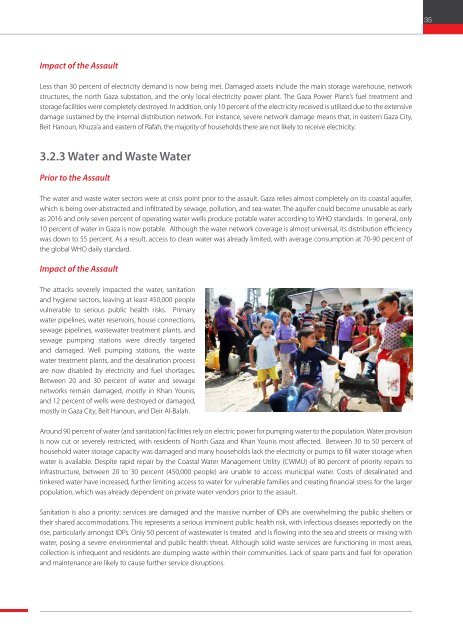National Early Recovery and Reconstruction Plan for Gaza 2014-2017_FINAL...
National Early Recovery and Reconstruction Plan for Gaza 2014-2017_FINAL...
National Early Recovery and Reconstruction Plan for Gaza 2014-2017_FINAL...
You also want an ePaper? Increase the reach of your titles
YUMPU automatically turns print PDFs into web optimized ePapers that Google loves.
35<br />
Impact of the Assault<br />
Less than 30 percent of electricity dem<strong>and</strong> is now being met. Damaged assets include the main storage warehouse, network<br />
structures, the north <strong>Gaza</strong> substation, <strong>and</strong> the only local electricity power plant. The <strong>Gaza</strong> Power <strong>Plan</strong>t’s fuel treatment <strong>and</strong><br />
storage facilities were completely destroyed. In addition, only 10 percent of the electricity received is utilized due to the extensive<br />
damage sustained by the internal distribution network. For instance, severe network damage means that, in eastern <strong>Gaza</strong> City,<br />
Beit Hanoun, Khuza’a <strong>and</strong> eastern of Rafah, the majority of households there are not likely to receive electricity.<br />
3.2.3 Water <strong>and</strong> Waste Water<br />
Prior to the Assault<br />
The water <strong>and</strong> waste water sectors were at crisis point prior to the assault. <strong>Gaza</strong> relies almost completely on its coastal aquifer,<br />
which is being over-abstracted <strong>and</strong> infiltrated by sewage, pollution, <strong>and</strong> sea-water. The aquifer could become unusable as early<br />
as 2016 <strong>and</strong> only seven percent of operating water wells produce potable water according to WHO st<strong>and</strong>ards. In general, only<br />
10 percent of water in <strong>Gaza</strong> is now potable. Although the water network coverage is almost universal, its distribution efficiency<br />
was down to 55 percent. As a result, access to clean water was already limited, with average consumption at 70-90 percent of<br />
the global WHO daily st<strong>and</strong>ard.<br />
Impact of the Assault<br />
The attacks severely impacted the water, sanitation<br />
<strong>and</strong> hygiene sectors, leaving at least 450,000 people<br />
vulnerable to serious public health risks. Primary<br />
water pipelines, water reservoirs, house connections,<br />
sewage pipelines, wastewater treatment plants, <strong>and</strong><br />
sewage pumping stations were directly targeted<br />
<strong>and</strong> damaged. Well pumping stations, the waste<br />
water treatment plants, <strong>and</strong> the desalination process<br />
are now disabled by electricity <strong>and</strong> fuel shortages.<br />
Between 20 <strong>and</strong> 30 percent of water <strong>and</strong> sewage<br />
networks remain damaged, mostly in Khan Younis,<br />
<strong>and</strong> 12 percent of wells were destroyed or damaged,<br />
mostly in <strong>Gaza</strong> City, Beit Hanoun, <strong>and</strong> Deir Al-Balah.<br />
Around 90 percent of water (<strong>and</strong> sanitation) facilities rely on electric power <strong>for</strong> pumping water to the population. Water provision<br />
is now cut or severely restricted, with residents of North <strong>Gaza</strong> <strong>and</strong> Khan Younis most affected. Between 30 to 50 percent of<br />
household water storage capacity was damaged <strong>and</strong> many households lack the electricity or pumps to fill water storage when<br />
water is available. Despite rapid repair by the Coastal Water Management Utility (CWMU) of 80 percent of priority repairs to<br />
infrastructure, between 20 to 30 percent (450,000 people) are unable to access municipal water. Costs of desalinated <strong>and</strong><br />
tinkered water have increased, further limiting access to water <strong>for</strong> vulnerable families <strong>and</strong> creating financial stress <strong>for</strong> the larger<br />
population, which was already dependent on private water vendors prior to the assault.<br />
Sanitation is also a priority: services are damaged <strong>and</strong> the massive number of IDPs are overwhelming the public shelters or<br />
their shared accommodations. This represents a serious imminent public health risk, with infectious diseases reportedly on the<br />
rise, particularly amongst IDPs. Only 50 percent of wastewater is treated <strong>and</strong> is flowing into the sea <strong>and</strong> streets or mixing with<br />
water, posing a severe environmental <strong>and</strong> public health threat. Although solid waste services are functioning in most areas,<br />
collection is infrequent <strong>and</strong> residents are dumping waste within their communities. Lack of spare parts <strong>and</strong> fuel <strong>for</strong> operation<br />
<strong>and</strong> maintenance are likely to cause further service disruptions.


